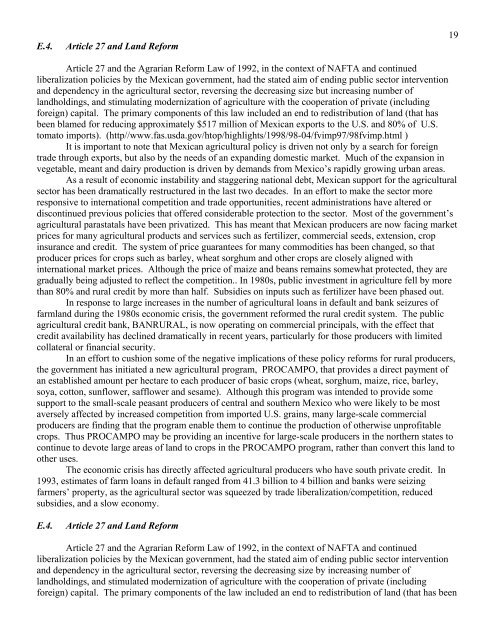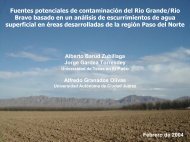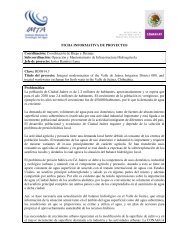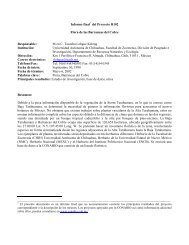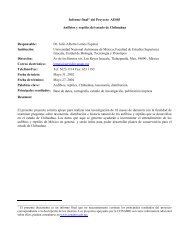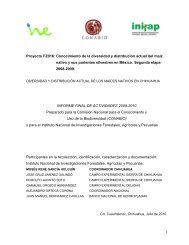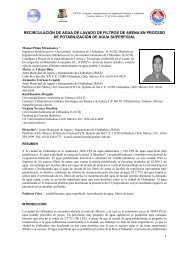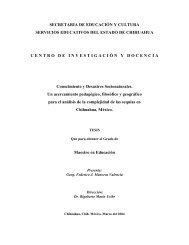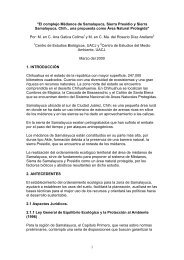land use and land tenure change in the - El Colegio de Chihuahua
land use and land tenure change in the - El Colegio de Chihuahua
land use and land tenure change in the - El Colegio de Chihuahua
You also want an ePaper? Increase the reach of your titles
YUMPU automatically turns print PDFs into web optimized ePapers that Google loves.
E.4.Article 27 <strong>and</strong> L<strong>and</strong> Reform19Article 27 <strong>and</strong> <strong>the</strong> Agrarian Reform Law of 1992, <strong>in</strong> <strong>the</strong> context of NAFTA <strong>and</strong> cont<strong>in</strong>uedliberalization policies by <strong>the</strong> Mexican government, had <strong>the</strong> stated aim of end<strong>in</strong>g public sector <strong>in</strong>tervention<strong>and</strong> <strong>de</strong>pen<strong>de</strong>ncy <strong>in</strong> <strong>the</strong> agricultural sector, revers<strong>in</strong>g <strong>the</strong> <strong>de</strong>creas<strong>in</strong>g size but <strong>in</strong>creas<strong>in</strong>g number of<strong>l<strong>and</strong></strong>hold<strong>in</strong>gs, <strong>and</strong> stimulat<strong>in</strong>g mo<strong>de</strong>rnization of agriculture with <strong>the</strong> cooperation of private (<strong>in</strong>clud<strong>in</strong>gforeign) capital. The primary components of this law <strong>in</strong>clu<strong>de</strong>d an end to redistribution of <strong>l<strong>and</strong></strong> (that hasbeen blamed for reduc<strong>in</strong>g approximately $517 million of Mexican exports to <strong>the</strong> U.S. <strong>and</strong> 80% of U.S.tomato imports). (http//www.fas.usda.gov/htop/highlights/1998/98-04/fvimp97/98fvimp.html )It is important to note that Mexican agricultural policy is driven not only by a search for foreigntra<strong>de</strong> through exports, but also by <strong>the</strong> needs of an exp<strong>and</strong><strong>in</strong>g domestic market. Much of <strong>the</strong> expansion <strong>in</strong>vegetable, meant <strong>and</strong> dairy production is driven by <strong>de</strong>m<strong>and</strong>s from Mexico’s rapidly grow<strong>in</strong>g urban areas.As a result of economic <strong>in</strong>stability <strong>and</strong> stagger<strong>in</strong>g national <strong>de</strong>bt, Mexican support for <strong>the</strong> agriculturalsector has been dramatically restructured <strong>in</strong> <strong>the</strong> last two <strong>de</strong>ca<strong>de</strong>s. In an effort to make <strong>the</strong> sector moreresponsive to <strong>in</strong>ternational competition <strong>and</strong> tra<strong>de</strong> opportunities, recent adm<strong>in</strong>istrations have altered ordiscont<strong>in</strong>ued previous policies that offered consi<strong>de</strong>rable protection to <strong>the</strong> sector. Most of <strong>the</strong> government’sagricultural parastatals have been privatized. This has meant that Mexican producers are now fac<strong>in</strong>g marketprices for many agricultural products <strong>and</strong> services such as fertilizer, commercial seeds, extension, crop<strong>in</strong>surance <strong>and</strong> credit. The system of price guarantees for many commodities has been <strong>change</strong>d, so thatproducer prices for crops such as barley, wheat sorghum <strong>and</strong> o<strong>the</strong>r crops are closely aligned with<strong>in</strong>ternational market prices. Although <strong>the</strong> price of maize <strong>and</strong> beans rema<strong>in</strong>s somewhat protected, <strong>the</strong>y aregradually be<strong>in</strong>g adjusted to reflect <strong>the</strong> competition.. In 1980s, public <strong>in</strong>vestment <strong>in</strong> agriculture fell by morethan 80% <strong>and</strong> rural credit by more than half. Subsidies on <strong>in</strong>puts such as fertilizer have been phased out.In response to large <strong>in</strong>creases <strong>in</strong> <strong>the</strong> number of agricultural loans <strong>in</strong> <strong>de</strong>fault <strong>and</strong> bank seizures offarm<strong>l<strong>and</strong></strong> dur<strong>in</strong>g <strong>the</strong> 1980s economic crisis, <strong>the</strong> government reformed <strong>the</strong> rural credit system. The publicagricultural credit bank, BANRURAL, is now operat<strong>in</strong>g on commercial pr<strong>in</strong>cipals, with <strong>the</strong> effect thatcredit availability has <strong>de</strong>cl<strong>in</strong>ed dramatically <strong>in</strong> recent years, particularly for those producers with limitedcollateral or f<strong>in</strong>ancial security.In an effort to cushion some of <strong>the</strong> negative implications of <strong>the</strong>se policy reforms for rural producers,<strong>the</strong> government has <strong>in</strong>itiated a new agricultural program, PROCAMPO, that provi<strong>de</strong>s a direct payment ofan established amount per hectare to each producer of basic crops (wheat, sorghum, maize, rice, barley,soya, cotton, sunflower, safflower <strong>and</strong> sesame). Although this program was <strong>in</strong>ten<strong>de</strong>d to provi<strong>de</strong> somesupport to <strong>the</strong> small-scale peasant producers of central <strong>and</strong> sou<strong>the</strong>rn Mexico who were likely to be mostaversely affected by <strong>in</strong>creased competition from imported U.S. gra<strong>in</strong>s, many large-scale commercialproducers are f<strong>in</strong>d<strong>in</strong>g that <strong>the</strong> program enable <strong>the</strong>m to cont<strong>in</strong>ue <strong>the</strong> production of o<strong>the</strong>rwise unprofitablecrops. Thus PROCAMPO may be provid<strong>in</strong>g an <strong>in</strong>centive for large-scale producers <strong>in</strong> <strong>the</strong> nor<strong>the</strong>rn states tocont<strong>in</strong>ue to <strong>de</strong>vote large areas of <strong>l<strong>and</strong></strong> to crops <strong>in</strong> <strong>the</strong> PROCAMPO program, ra<strong>the</strong>r than convert this <strong>l<strong>and</strong></strong> too<strong>the</strong>r <strong>use</strong>s.The economic crisis has directly affected agricultural producers who have south private credit. In1993, estimates of farm loans <strong>in</strong> <strong>de</strong>fault ranged from 41.3 billion to 4 billion <strong>and</strong> banks were seiz<strong>in</strong>gfarmers’ property, as <strong>the</strong> agricultural sector was squeezed by tra<strong>de</strong> liberalization/competition, reducedsubsidies, <strong>and</strong> a slow economy.E.4.Article 27 <strong>and</strong> L<strong>and</strong> ReformArticle 27 <strong>and</strong> <strong>the</strong> Agrarian Reform Law of 1992, <strong>in</strong> <strong>the</strong> context of NAFTA <strong>and</strong> cont<strong>in</strong>uedliberalization policies by <strong>the</strong> Mexican government, had <strong>the</strong> stated aim of end<strong>in</strong>g public sector <strong>in</strong>tervention<strong>and</strong> <strong>de</strong>pen<strong>de</strong>ncy <strong>in</strong> <strong>the</strong> agricultural sector, revers<strong>in</strong>g <strong>the</strong> <strong>de</strong>creas<strong>in</strong>g size by <strong>in</strong>creas<strong>in</strong>g number of<strong>l<strong>and</strong></strong>hold<strong>in</strong>gs, <strong>and</strong> stimulated mo<strong>de</strong>rnization of agriculture with <strong>the</strong> cooperation of private (<strong>in</strong>clud<strong>in</strong>gforeign) capital. The primary components of <strong>the</strong> law <strong>in</strong>clu<strong>de</strong>d an end to redistribution of <strong>l<strong>and</strong></strong> (that has been


